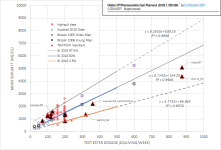| Weekly Dose Other Compunds (mg) | Mg |
| Weeks Run | Inter Number of Weeks |
| Draw Time from Last Pin | Insert Hours from last pin to draw |
Respectfully, the template table should also include injection frequency for the weekly dose total. While I understand the wiki lists requirements for hours post injection prior to blood draw, these instructions (without considering injection frequency) create a discrepancy for comparison of results and computed "multiplier".
Time for blood to be drawn:
- Test P & A 12-24 hours after last pin. You need to not have been on any long esters for 3 weeks beforehand and you need to have been on Test P/A for minimum 3 weeks.
- Test E 36-48 hours after last pin. You need to be on for at least 5 weeks.
- Test C 48-60 hours after last pin. You need to be on for at least 5 weeks.
To repeat, a member's TT by LCMS may be drastically different if injecting ED vs E7D and then pulling blood work at the requested hours post injection found in the Wiki. What's needed is a common basis for calculated multiplier (namely,
mean serum TT level) to bring self-consistency across all injection frequencies.
As an improvement to current system employed, especially given that the PK profile of Test E and Test C are basically interchangeable, I'd respectfully submit using a pharmacokinetic conversion table (similar to attached) to convert
trough measurement to
mean level (assumes 8 hr absorption half life / 4.5 day elimination half life). There is only one trough no matter the injection frequency, and it is easy to time with blood draw.
Also for fun, I've included a dose response graph showing 2.5, 50, and 97.5 percentile "multipliers" based on published PK studies along with some crowdsourced data.
I would welcome any and all feedback if there is interest.


Would be happy to make another table for Test P. Yes, to be clear, the graph is intended for Test E/Test C. Would need correction for Test P.
In conclusion, with this harmonized approach the multipliers will fall between 3.5 and 9 for vast majority of users. A bunch of additional details to consider as well. Using an oral like oxandrolone will crush SHBG and make TT multiplier lower than without. So perhaps there could be additional constraints implemented for this system.
Comments on this section of Wiki:
Provided the bloods were drawn according to the timetable above, the test multiplier (test levels in ng/dl divided by weekly dose of test in mg) needs to be above 4.0x to count as good blood work. Test multipliers below 4x will be counted as bad bloodwork. Prior blood work may be taken into account (i.e. if a user has gotten bloodwork 5 times and consistently converts at a 4x multiplier from pharma test and various SST source’s test, then this will not be counted as bad bloodwork) at the discretion of the mods.
As shown in graph above, a floor of 4x is too high to demonstrate "good" blood work. Using the harmonized approach I've introduced here, the 95% confidence interval includes a multiplier of 4x. Less than 3.5x would be reasonable if a member isn't crushing their SHBG. We can discuss how tight management would want the confidence interval...95, 99, 99.5%, etc. It is all doable with the math.
Thanks for taking the time to read!




